Building a New Tradition
by Tom Ellis III
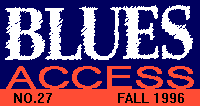
| Paul Butterfield Building a New Tradition by Tom Ellis III |
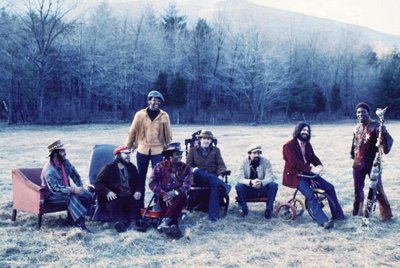
"You see, the snake is like the music I'm involved
with, continuously shedding layers of skin and taking on different
forms. You hear what I'm saying? The music that Charlie
Parker made was beautiful, but if you say that it was the ultimate
form of music, what you're actually saying is that evolution
is over, that jazz is dead.
"I've become very interested in Charlie Parker, but not from the standpoint of playing his music or music based on his, because that would result in a stylized piece of music rather than something that takes account of the bigger picture. I know from what I've read and heard about him that Charlie Parker himself was evolving when he died and would have brought his wider perspective to the music's next evolutional stage."
-- Composer Henry Threadgill discussing the evolution of a musical form
Early in 1969 the Butterfield Blues Band was evolving once again.
Late in 1968 Elvin Bishop and Mark Naftalin had departed. The last two remaining members of Butterfield's first, ground-breaking ensemble, both had been integral in helping set the band's vision, especially as it ventured into new territory with the addition of the brass section.
Now the most familiar faces in the band were those of the horn players and drummer Philip Wilson, jazz men all; the guitar players so dominant in framing the Chicago blues music of Butterfield's early years would never again play a role like they had in his band's past.
Throughout the remainder of its existence the Butterfield Blues Band would walk a more innovative and progressive road than even Butterfield himself could have imagined. In the 1940s a group of players -- including Count Basie, Lester Young and Charlie Christian -- helped put jazz back in touch with the blues. From 1968 to 1971 Butterfield -- along with his horn section and arranger/pianist Ted Harris -- put the blues back in touch with jazz.
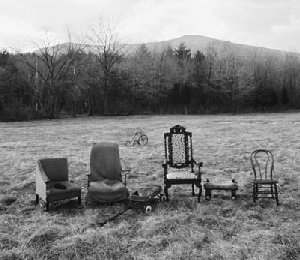 Initially only he would be replaced, and over the next few months
the band tried unsuccessfully to do so, finally resorting to auditions
at a New York practice hall in the search.
Initially only he would be replaced, and over the next few months
the band tried unsuccessfully to do so, finally resorting to auditions
at a New York practice hall in the search.
It was a laborious process that would be resolved with the beginning of a new career. Keith Johnson remembers: "We had auditions in a small studio in New York we'd used to rehearse in years earlier. I don't remember how we got the word out, but we were there for a couple of weeks -- three to four days a week -- and what we'd do is have a guitar player come in and play two or three tunes with the full band. All of them were very good; each one had something going and could play, but none of them were very distinctive. We were all getting discouraged after seeing 20 guitarists over a few weeks.
"But there was one more guy to see. So we send word to have him come in, and we hear this weird screeching sound coming down the hall; it was this guy, dragging in his own, home-built amplifier," says Johnson. "The corners weren't even sawed off, and he's got his guitar on top of it -- no case -- and it's fire-engine red with a huge road runner decal on it. And he looks like he's 11 years old.
"So he comes in, and we're all chuckling under our breath, pretty amused. And we played a few tunes. And we all said, 'That guy doesn't know how to play the blues at all,' which he later admitted. But he had a fire -- he had his own style, his own thing together, and at that point we all realized that the homemade amp and the road-runner decal became a big positive. He just had a huge will to play, a lot like Elvin, and we all said, 'This is the guy.' He was a young man on fire -- lots of talent."
The young man in question -- 19 years old -- was Buzz Feiten. A child prodigy of the first rate, Feiten was at the Mannes College of Music studying French horn when he answered Butterfield's audition call. "I had no idea what I was getting into," he remembers. "I was just a punk kid from Long Island listening to the Butterfield band when I was in high school. I graduated and started to teach myself to play a little guitar, but I was mostly playing bass at the time.
"I moved to New York and started seeing one of the former band member's ex-wives -- she knew Elvin and the guys in the band. I was going to Mannes playing the French horn, and my heart just wasn't in it, so I started to really practice the guitar. Through my girlfriend I got an audition with Elvin and went up and tried out on bass. He liked my playing but didn't think it was right for him. But he called Paul and told him to give me a listen -- this is in 1968. There's a club in New York called The Generation -- it became Electric Lady Studios later -- and we went to see B.B. King. There were jam sessions after the show, and Butter invited me through Elvin to come down and play bass.
"I'm the first guy there setting up my stuff, and up on stage comes Butterfield, Elvin, Al Kooper, Jimi Hendrix, Sanborn, Phillip Wilson, B.B. King. I was just a kid from high school, and I'd never even seen these guys. I thought I'd died and gone to heaven! We played 'til six in the morning. Butter liked me and said, 'Why don't you call and come to an audition?'
"I did have the cheesy amp and guitar, but I was very cocky and demanded that I get to play. I was really impatient. I had just really started to play the guitar seriously for about a year, and I wasn't a blues player, but I was real influenced by Clapton and especially Albert King. But I also listened to the Motown guitarists and Mavis Staples -- I didn't have roots in blues.
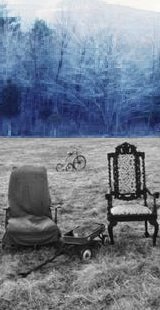
"It was so weird -- I was just a kid. And I owe these guys such a debt. They could have been nasty or patronizing, but they just took me in. I wasn't half the musician any of them was. Dave Sanborn and Gene Dinwiddie were monsters -- they could play bebop or just anything, and Butterfield was a complete monster genius. And here I am, really not coming from anywhere but the suburbs!! I mean I'd never played with a horn section. I'd only had one professional gig in my life!"
Feiten brought a youthful exuberance that energized the band, especially onstage (his performance at the Woodstock Festival was a memorable example). If he ignited a fire, Steve Madaio, a friend of his from Mannes, threw fuel on it. "By the time I got to Mannes I had done shows at the Copacabana and done gigs with Screamin' Jay Hawkins," Madaio says. "And I knew what I wanted to do and wanted to stay in New York. I was classically trained too, and when I was at Mannes I ran into Buzzy, who was studying French horn and had some rock'n'roll things going on, which I wasn't into much, although I had done a Beach Boy tour when I was 18. Buzz left and joined Butterfield, then called me to come up and sit in with the band in Woodstock.
"Most of the music I'd played to that point had been very structured -- I'd never even heard the band, had no idea of this type of music. Sanborn had that hypnotic sound, and Gene Dinwiddie was like a very cool jazz cat, and Phillip Wilson was quick to play free -- a monster. Keith was mostly playing organ, although we'd double up on trumpets sometime. The band would play the head of a song, and then it would free up, which was perfect for me -- some structure but a chance to play solo. It really intrigued me, was real cool, kind of like a jazz quartet." Johnson remembers that "Steve was an absolute motherfucker, a young 21-year-old whose father was also a trumpet player, and he was always pushing me."
The band's free-blowing episodes -- both onstage and in rehearsal -- were further enlivened by the addition of Rod Hicks, fresh from Detroit and Aretha Franklin's unit. Hicks played fretless bass, had near-manic stage energy and loved the freedom the band allowed; on stage he seemed to set fires under his bandmates, and his solid R&B playing could shift suddenly to free time in synch with Wilson's intensity on drums, giving the band a new anchor and rhythmic propulsion in either setting.
Butterfield himself was pushed to new playing heights. At the time this ensemble was at full steam he was quoted as saying, "I wanted to get a chance to do something else, to try some other things and experiment. Actually, it's helped my playing. But I don't want to play all the solos on all the songs -- I want some other folks to play. I've got some cats that can really play!" Heading off in a new direction, the stage would be set for the next album, one that would cause the Butterfield Band to confront and deal with its multiple personalities, with both good and bad results.
Albert Grossman had become a powerful figure in the rock'n'roll business. A former folk-club owner from Chicago, Grossman had a tremendous ear for talent and was an early believer in many of the folk era/protest singers, taking on and shaping their careers like no one before. His adept manipulation of Bob Dylan -- a carefully performed marketing dance involving limiting access to Dylan's work and performances while building immense hype for him -- had created the first American giant of the pop era, a critical and business success. Grossman would shepherd others from the folk era, Peter Paul and Mary, Richie Havens and Joan Baez among them, to fame and fortune.
A ferocious businessman, Grossman owned GrosCourt Productions with John Court, and both were devoted to the music of their artists. So much so that not long after taking on the Butterfield Band in 1965 they put all the musicians on a salary, removing the financial worry usually associated with performing; this practice was a direct attempt to let the artists concentrate on their music, while GrosCourt took care of the financial end of the business.
A large man with long, white hair (he reminded many of Ben Franklin), Grossman's fatherly concern and protection for his artists drew many to GrosCourt like a magnet; their indulgence -- like allowing Butterfield and band extensive rehearsals before going into the studio with Court to produce In My Own Dream -- was often extravagant but frequently produced stunning results. The GrosCourt philosophy of business was that of a patron saint or benefactor, and many of their artists moved to Woodstock, where Grossman and Court had homes and from where they ran their business, establishing a modern-day artists' commune. GrosCourt's care of their musicians was unique even to this day (although by the early 1970s many of the artists would become suspicious and angry over the way their business affairs, money and careers had been handled, especially after Grossman and new partners took full control of the company).
By the time Butterfield and band were preparing to go into the
studio to record Keep On Moving, GrosCourt had a stable
of artists like no other -- Bloomfield, The Band, Janis
Joplin, Bob Dylan among them.
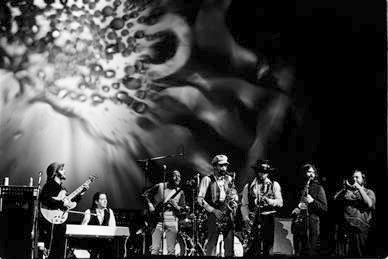 (His booking stature was so great
that when the organizers of Woodstock began planning their "pop
festival" they called him first, aware that without his
artists they had no show.) But even Grossman, with all his power,
had been unable to alter the changing path of the recording industry,
hungrier than ever to exploit the cash-cow rock'n'roll
had become, now more ready than ever to get involved in the recording
plans and efforts of the artists on their labels.
(His booking stature was so great
that when the organizers of Woodstock began planning their "pop
festival" they called him first, aware that without his
artists they had no show.) But even Grossman, with all his power,
had been unable to alter the changing path of the recording industry,
hungrier than ever to exploit the cash-cow rock'n'roll
had become, now more ready than ever to get involved in the recording
plans and efforts of the artists on their labels.
Keep On Moving then would be different from earlier Butterfield records -- no familiar face like that of old Cambridge buddy Paul Rothchild or patient, fatherly, albeit masterful partner John Court would be at the producer's helm. The record company wanted something else this time.
And what they wanted was a hit record from the Butterfield Band.
The band had envisioned something very different. As an indication of their new musical direction Gil Evans -- the great arranger for Miles Davis, who Johnson had run into, along with Ornette Coleman, at loft concerts in the East Village -- was contacted to write the charts for the album, and agreed to do so; his name would be withdrawn after it became apparent that his deliberate and systematic work ethic could not accommodate recording schedules.
In his place the band chose Ted Harris, like Hicks a Detroit native and a highly regarded arranger for "road bands," completing a gig with Tony Bennett while he worked on the arrangements for the songs. "I picked up the material in Woodstock but had to write the charts in Detroit -- we'd record all week in New York, and I'd head back to Detroit on the weekends." Butterfield would soon ask Harris to join the band.
Just as pleased with Harris' work was Jerry Ragovoy, record producer, musician, and owner of the Hit Factory (where the album was recorded and the premiere studio of the day), and himself a legend and power in the music business. Ragovoy was also famous as a writer, authoring "Piece of My Heart" and "Try" as well as "Time Is On My Side," a hit for Irma Thomas and the Rolling Stones' first U.S. Top 10 single. As a producer for United Artists in the late '50s, and head of A&R for Warner Brothers' R&B label, Loma, in the mid-'60s, Ragovoy was well known for his combinations of soul, blues and string arrangements, pioneering a deeply affecting take on R&B.
Although he found Harris' work solid, Ragovoy was not as happy with the Butterfield Band, and they didn't seem happy with him -- through no fault of either. "Jac Holzman at Elektra told me that he wanted a hit from the band, and they came to me because at that time in my life I was supposed to be the 'king' of R&B, and they wanted that kind of producer," Ragovoy says.
Although it was common for a label to select a producer for an artist, this was a new concept to Butterfield, who complained to band members that the record company was forcing things on him. Ragovoy was the best, but he was assigned by Elektra, not GrosCourt, and this caused problems from the beginning. The band wanted a jazzier album reflective of their live performances, Elektra a radio-ready, pop effort.
"I had such a dichotomy of emotion about these guys in the studio. I hated them, and I loved them," Ragovoy remembers. "Personally they all drove me a little nuts -- I couldn't seem to control them; I'm the kind of producer who wants to have total control in the studio -- it's my game and my vision. I'm going to sink or swim by my ideas.
"At one point I even called Holzman and told him I'd have to withdraw, but he talked me into staying. But at a certain point I gave up on my usual approach and went through the motions, letting them do what they wanted. I wound up going for a great sound, and I think I got that. But the project was rushed -- there wasn't time to select the material or to refine or redo the material we had done.
"In the end I wasn't happy with anything we had done -- even my things." Ragovoy had written and arranged 'Except You' and 'Where Did My Baby Go.' "But I'm not talking about the charts. Ted Harris did some wonderful arranging, and the horn players played well. I just wasn't happy with the end product. We did it in two or three weeks, and we should have had eight -- the potential was there for a great album."
But Ragovoy acknowledges the talent percolating in the group. "When I heard Sanborn and Buzz, I recognized they were both monsters. They were both natural, great talents; in fact, they were two of the great talents I've heard since I started producing. And I knew Butterfield wanted to stretch out. I heard a lot of jazz influences from the band. Paul was a great harp player, and I think a good blues singer, but I think he was overmatched by the jazz influence in the band. My feeling was that if he was going to move in the jazz format, then the material needed to be more carefully selected for Paul's voice so he could get through it naturally. I heard a fight then, and I hear it today when I listen again."
"I first met Paul on campus at the University of Chicago after I arrived from New York," says Dayron. "I had heard a lot of blues after I got there -- you couldn't help but hear a lot of blues on the South Side of Chicago -- and I started to fall in love with it. Paul was playing harmonica on campus when I first ran into him.
"We made a lot of trips into the South Side and hung out a lot at the Blue Flame, where Smokey Smothers was the act, and Paul would sit in there. We were totally naive about the dangers down there. We were there only out of love for the music and musicians. On the South Side and West Side, Paul and Mike would regularly sit in with everyone, from Muddy to Wolf, Chuck Berry, Little Milton, B.B. King and Sonny Boy Williamson. White people didn't go into these clubs then, and there was no precedent for them being there. When Paul and Mike went in it would be expressly out of their intention to sit in, and blow whoever it was -- Muddy or whoever -- right off the stage. Those two guys were focused on demonstrating that they could play as well as and with anybody up there. And what they did when they sat in was extraordinary.
"Butterfield was such a surprise to Muddy -- he was a superstar -- and they were allowed to sit in because people like Muddy realized how serious they were and recognized it for what it was. It was completely authentic, and very serious. Muddy and Wolf honored it. And that's another reason people like me and Peter Butterfield and Nick were not in danger -- we were with them."
Like Bishop, on an academic scholarship at the South Side university,
Dayron had answered an ad for a janitor at Chess; he knew this
was where the music he loved was being made.
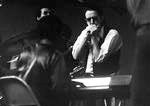 He soon became an
assistant engineer, then learned about producing from Willie Dixon
-- sitting in his sessions and watching how Dixon arranged
the music and worked with the artists. He and the Chess brothers
were the only whites there.
He soon became an
assistant engineer, then learned about producing from Willie Dixon
-- sitting in his sessions and watching how Dixon arranged
the music and worked with the artists. He and the Chess brothers
were the only whites there.
"But when Marshall Chess, who also knew Butterfield and had gone to high school with Bloomfield, joined the label, he initiated new projects. In some ways Marshall was more impressed with the white British blues bands -- he took Michael and Paul for granted because they were from Chicago. Mike and I were talking one night and Mike said, 'Let's do an album and call it Fathers and Sons -- let's recreate on record what Paul and I have been doing in the clubs.' They thought Muddy's bands were never up to the level of his greatness, and it was a fantasy to have a perfect band behind him. It was a natural and obvious idea, and Mike said, 'You do it.' But it was 1967, and I knew the Chess brothers wouldn't go for it, but I thought Marshall would love it. And he did and had the leverage with his father to make it work."
Two years would pass before the sessions would take place. "When Bloomfield saw it happen, when he showed up -- all the great Chess players were in the studio to watch and Spann, Muddy, Sammy Lay and Butterfield were there -- he was completely overwhelmed. He just couldn't handle it, and he ran away, headed straight back to the airport. My girlfriend went to the airport and literally dragged him back by his ear. But once the sessions got started he got over his nervousness, and things really went well."
Listening to the recordings today Bloomfield's playing seems muted, and Dayron agrees that he was in the background. "Mike didn't want to shine brighter than Muddy -- I had the same problem with Eric Clapton on The London Howlin' Wolf Sessions -- and I had to work hard in the mixing to deal with Mike's reluctance."
Butterfield, however, did not have that problem. "Paul
was wonderful on those sessions. He came in ready to go to work
and did everything I requested with good humor and fun. He was
two ways on the sessions -- deadly serious and playing his
ass off or just having a great time hanging out.
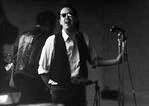 He was unusually
sociable and seemed to enjoy himself more than I'd ever
seen -- he was good friends with Muddy and Spann. Butterfield
was just superb."
He was unusually
sociable and seemed to enjoy himself more than I'd ever
seen -- he was good friends with Muddy and Spann. Butterfield
was just superb."
The song list for the sessions was made up of a panoply of blues standards recognized as the greatest of Muddy's songs. The musical environment created was very special. Muddy told down beat, "I think this was one of the greatest sessions we did since Little Walter's time and Jimmy Rogers'. We was close to the old sound," adding, "it's about as close as I've been to it since I first recorded it." Spann said, "It did remind me of old times. I had more feeling in the session than I've had in a long time. It's a funny thing: The people say the white kids can't play the blues, but that's wrong."
Butterfield's playing, out front and center, resonates throughout. It's not comparable to anything else. Anyone who thinks now, or thought then, that Butterfield wasn't the successor to Little Walter hasn't listened to his playing on Fathers and Sons.
Dayron agrees. "That's dead accurate. There's a certain purity to his playing, very unlike the Butterfield Band sound, where he plays very inside the other musicians and the overtones of their instruments, backing Muddy as part of a powerful band. There weren't the openings he had with his bands -- there was a real complexity to everyone playing together. Listening to Paul was mind-blowing -- he sounds like he's been playing those songs all his life."
Muddy was in great voice, and Spann showed flashes of brilliance, obviously slowed a bit by a heart attack earlier that year. Dunn and Lay are solid, with Lay showing why he is such a great shuffle drummer, and 18-year-old chromatic harp player Jeff Carp, highly touted by Dayron at the time, displays wonderful chromatic work on "All Aboard."
It was a two-album set, one studio LP, one live. The studio recordings are the highlight, with recording problems evident on the live material, although "The Same Thing" from the latter is as haunting and perfect as a deep blues can be, and Muddy works the crowd into a frenzy with the final lines of "Long Distance Call." Pete Welding's review in Rolling Stone would extol Butterfield's playing throughout, especially its "perfect complement to Muddy's singing," declaring the recording "one of the finest sets of performances from Muddy in quite a while." Muddy himself was elated with the session work and the live shows, stunned by the outpouring of affection shown him by the Chicago audience that night on April 24, 1969. The album was a commercial success for Chess, but a subsequent reunion was never assembled.
"Muddy was relieved that he could get involved with anything as serious as this production," Dayron notes. "His golden period was far behind him. He had been humiliated by many things Chess had done with him, and he was somewhat cynical about the projects given to him at this time, and once he did Electric Mud this became worse. The fact that he had a respectful relationship with Butterfield and Bloomfield and knew people like Sam Lay and Duck Dunn, and the idea we could do a really cooking session with him, was exciting. And he even enjoyed doing the live concert, because up to that point he had never appeared before such a large audience.
"People went berserk at the concert, and Muddy had never had an experience like that, where he could play a note and 4,000 people would go insane. It had never, ever happened. He loved the adoration and the sessions; I had listened to everything he had ever done, and went over the songs with him beforehand -- also something no one had ever done! And I think the record holds up in a lot of ways."
Dayron would continue on at Chess, but not work with his old friend Butterfield again. "I was not as close to Paul as Michael, but I will say that Paul Butterfield was a bona fide artistic genius. Paul Butterfield was a giant, recognized as such by other giants. He carved a niche in his own unique style -- he was the real thing, in every part of his being, whether he was at the Blue Flame, playing at a Hyde Park house party, or whatever -- he was always the real thing."
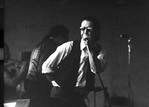
This is an abridged version of the Paul Butterfield article. For the complete article, get the hard-copy version of BLUES ACCESS.
 |
 |